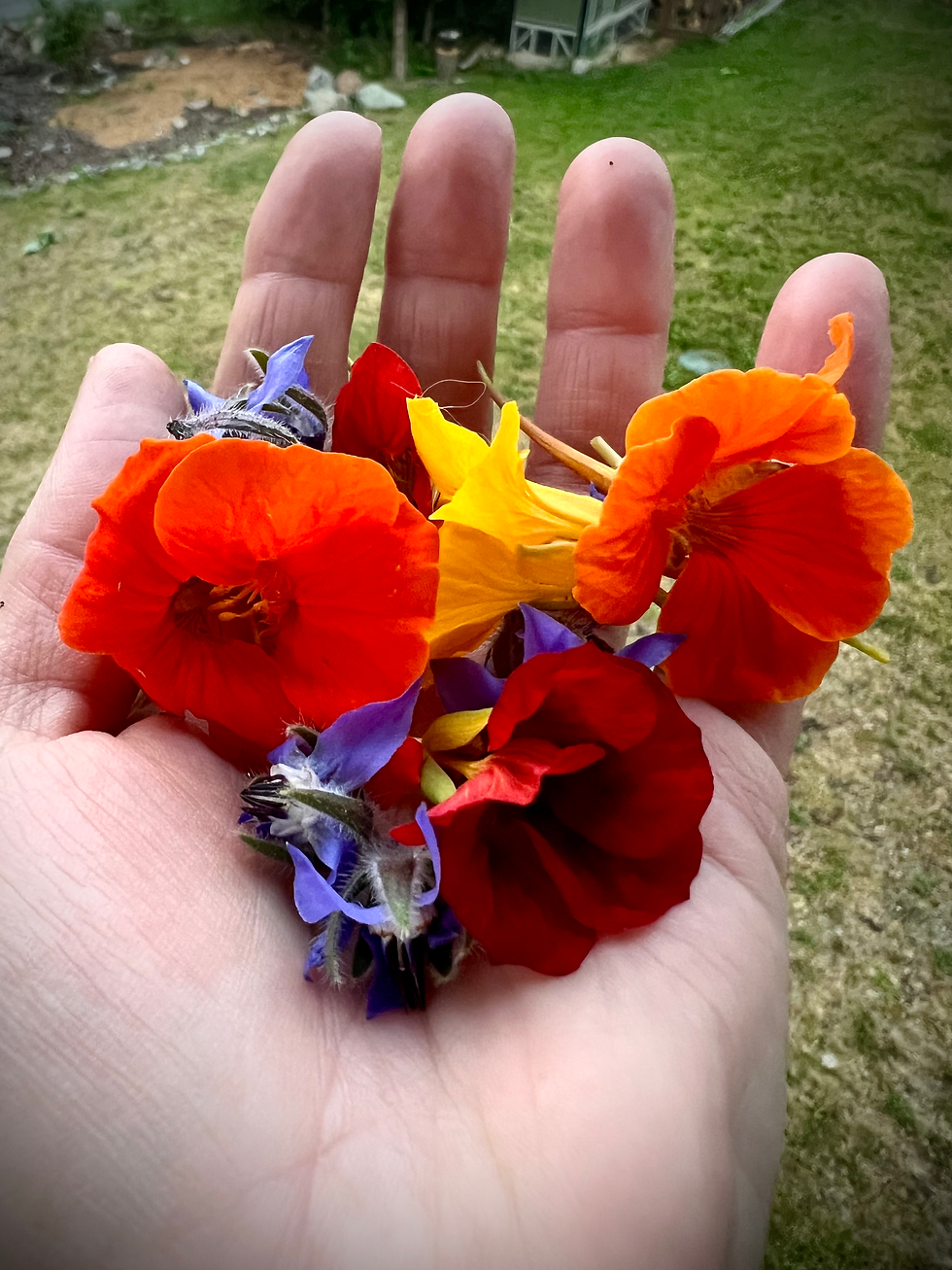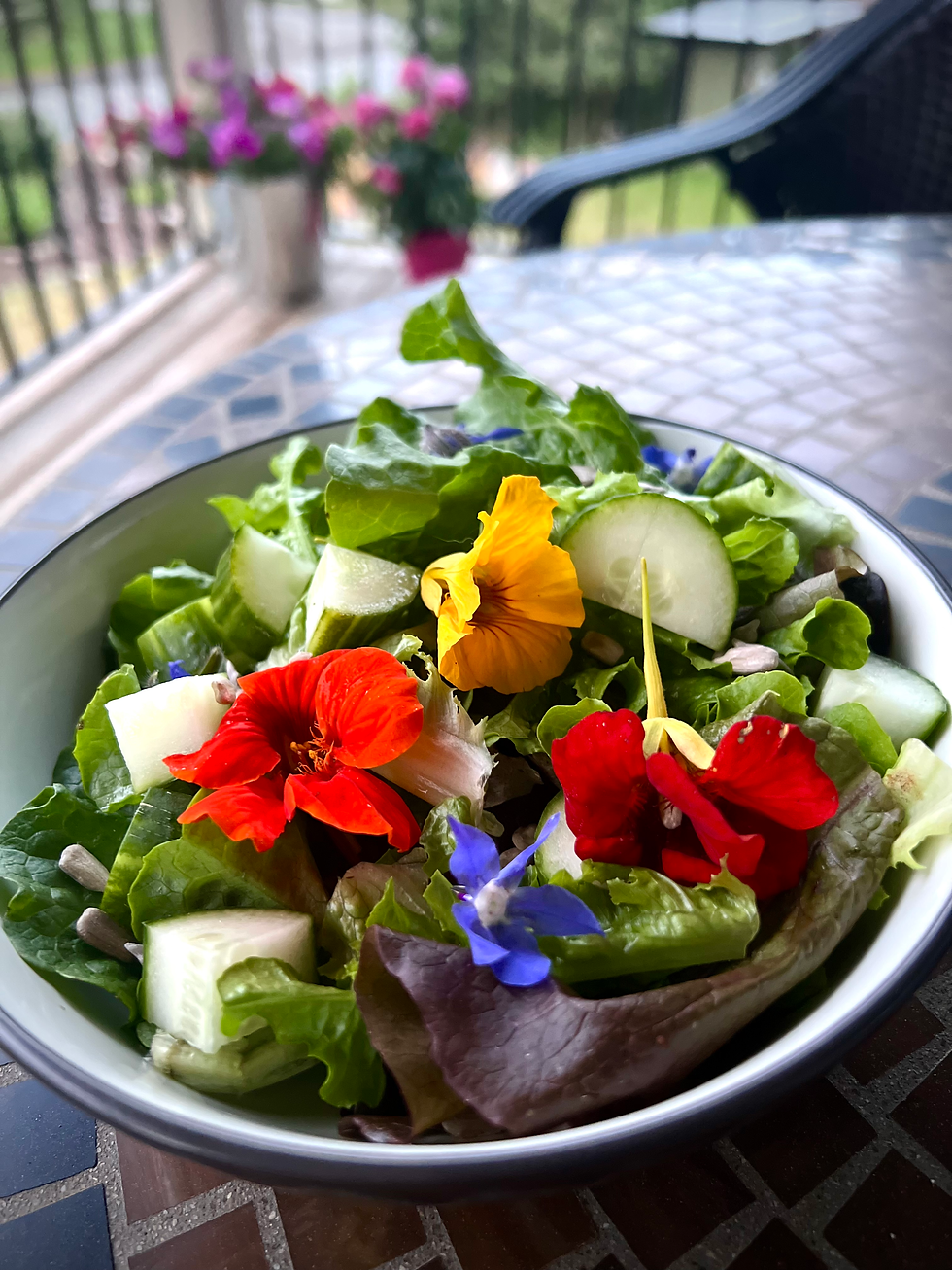The Delicate Delight of Edible Flowers: A Guide to Safe Foraging and Enjoyment
- Stevie Vanhalen

- Jun 20
- 7 min read
Flowers aren't just for admiring in gardens or vases—they can also be a delicious and vibrant addition to your meals! From salads to desserts, edible flowers bring color, flavor, and a touch of whimsy to culinary creations. However, before you start plucking petals, it’s critical to understand which flowers are safe to eat, how to harvest them responsibly, and which parts of the plant are edible. This guide will walk you through the world of edible flowers, highlighting key harvesting tips and safety precautions to ensure a delightful and safe experience.

Why Eat Flowers?
Edible flowers have been used in cuisines worldwide for centuries, adding unique flavors and visual appeal to dishes. From the peppery bite of nasturtiums to the sweet nectar of honeysuckle, flowers can elevate your cooking with their diverse tastes and textures. They’re also packed with nutrients—many contain vitamins, antioxidants, and minerals. Plus, incorporating flowers into your meals is a fun way to connect with nature and explore new culinary horizons.
Popular Edible Flowers and Their Uses
Here are just a few common edible flowers, their flavors, and the parts of the plant you can safely consume:
Basil : Most growers use basil’s leaves (Ocimum basilicum) before the plant has flowered. After blooming, the character of the leaves changes and becomes less appealing, but the flowers can be eaten. They may be white to lavender, but they look stunning when sprinkled over pasta. Thai basil is sometimes allowed to flower before whole stems, with leaves attached, are harvested. The whole flower is edible.
Borage: Borage flowers have a cucumber-like taste and are commonly used in salads and as a garnish. They pair well with nasturtiums.
Chamomile: Nearly every part of the plant can be used in some form. The flower petals offer a slightly sweet, apple-like, with a mild, floral taste.
Chives: Wonderful onion flavor! I have used these in chive salts, compound butters, and making chive vinaigrette. The entire plant is ediable. For a garlic punch use garlic chives.
Clover: The flower heads of clover (Trifolium spp.) are edible, and have a sweet, mild liquorice flavour. In fact, the whole above ground plant is edible, but it’s best to grow clover as tender sprouts or to use the flower tubes in moderation as a salad garnish. Mature clover is tough to digest, and may cause bloating.
Dandelion: Often considered a weed, dandelions are entirely edible. The flowers have a mildly sweet, honey-like flavor, while the leaves are slightly bitter. Use the petals in salads, teas, or even to make dandelion wine. The roots can be roasted for a coffee-like beverage.
Dill: is a wonderfully aromatic herb that’s not only a popular culinary herb but also has medicinal uses. The fronds have a fresh, slightly tangy flavor.
Hibiscus: Known for its tart, cranberry-like flavor, hibiscus flowers are often used in teas, cocktails, or desserts. Only the petals are typically consumed.
Lavender Buds: I love adding these to cookie recipes, Earl grey tea, and cocktails. Gives off a very nice floral herby note.
Lilac: Have a delicate, floral flavor with a slightly sweet and perfumy taste, often described as having citrusy or lemony undertones. Consume only flowers and in moderation amounts.
Nasturtium: These vibrant orange, yellow, or red flowers have a peppery, slightly spicy flavor, similar to arugula. Both the flowers and leaves are edible and make a fantastic addition to salads or as a garnish for savory dishes.
Pea Flowers Mild, sweet, and slightly vegetal flavor, reminiscent of fresh peas or a delicate, grassy noteOnly eat flowers from edible pea plants: Ensure the flowers come from garden peas or snap peas, not ornamental sweet peas (Lathyrus odoratus), which are toxic and can cause neurological or digestive issues.
Primrose: Most well-known for producing evening primrose oil, which is rich in gamma-linolenic acid (GLA), an omega-6 fatty acid with potential health benefits. Leaves have a slight peppery flavor.
Rose: Roses offer a fragrant, slightly sweet flavor. The petals are edible and can be used in jams, jellies, teas, or as a garnish. Be sure to remove the bitter white base of the petals before eating.
Sunflower: The sprout can be used as microgreens in salads, The seeds are most consumed part. Petals taste is slightly bitter and floral; mainly decorative.
Violet: These delicate purple flowers have a sweet, floral taste. They’re perfect for decorating cakes, infusing into syrups, or tossing into salads. The leaves are also edible and can be used in salads or cooked like greens.
Always verify the edibility of a flower before consuming it, as some varieties within a species may not be safe. For example, only certain types of roses are edible, and the hips (fruit) of some rose varieties are more commonly used than the petals.
Harvesting Edible Flowers: Key Tips for Safety
To safely enjoy edible flowers, proper harvesting practices are essential. Here are some critical guidelines to follow:
1. Avoid Flowers Near Roads or Contaminated Areas
Never gather flowers from areas exposed to pollutants, such as roadsides, industrial sites, or places treated with pesticides or herbicides. These flowers may absorb harmful chemicals, making them unsafe to eat. Instead, harvest from organic gardens, your own backyard, or trusted wild areas free from contamination. If you’re unsure about the area’s safety, it’s better to err on the side of caution and avoid foraging there.
2. Know Which Parts of the Plant Are Edible
Not all parts of a flower or plant are safe to eat. For example:
With roses, only the petals are typically consumed, and you should remove the bitter white base.
For dandelions, the flowers, leaves, and roots are edible, but the stems can be bitter and less palatable.
Some flowers, like nasturtiums, have edible leaves and flowers, but the seeds may require specific preparation to be safe.
Also understand what parts and active constiuents that could give harmful or adverse reactions. While you may not need to be a Master Herbalist or chemistry major it is important to do your due diligence in research.
Always research the specific plant to understand which parts are edible and how to prepare them. Misidentifying or consuming the wrong part of a plant can lead to digestive issues or worse.
3. Correct Plant Identification Is Crucial
Many flowers look similar, but some are toxic and can cause severe illness or even be fatal. For example:
Foxglove (Digitalis) resembles some edible flowers but is highly toxic and can cause heart problems due to it's cardiac glycoside compounds.
Lily of the Valley looks delicate and harmless but is poisonous if ingested.
Oleander is another beautiful but deadly flower that should never be consumed.
Before foraging or eating any flower, use a reliable field guide or consult an expert to confirm its identity. Apps like PlantSnap or iNaturalist can help with identification, but cross-reference with a trusted botanical resource. If you’re new to foraging, consider taking a workshop or joining a local foraging group to learn from experienced guides.
4. Harvest Responsibly
To protect both the plant and the ecosystem, follow these sustainable harvesting practices:
Pick sparingly: Take only what you need, leaving plenty of flowers for pollinators and future growth.
Harvest in the morning: Flowers are freshest in the early morning when their water content is highest.
Use clean tools: Use scissors or pruning shears to avoid damaging the plant, and wash flowers gently before eating to remove dirt or insects.
Avoid over-harvesting: Never strip a plant bare, as this can harm its ability to reproduce and disrupt local wildlife.
Toxic Flowers to Avoid
While many flowers are edible, others are dangerous. In addition to foxglove, lily of the valley, and oleander, steer clear of:
Daffodils: All parts are toxic and can cause nausea and vomiting.
Azaleas: These vibrant flowers are poisonous and can lead to severe gastrointestinal distress.
Hydrangeas: Contain compounds that can cause cyanide-like poisoning in large amounts.
When in doubt, don’t eat it. Always double-check the identity of a flower before consuming it, and if you’re unsure, consult a professional or avoid it altogether.
How to Incorporate Edible Flowers Into Your Meals

Once you’ve safely harvested your flowers, here are some creative ways to use them:
Salads: Toss nasturtium, violet, or dandelion petals into a green salad for a pop of color and flavor.
Garnishes: Use rose or hibiscus petals to decorate cakes, cocktails, or charcuterie boards.
Infusions: Steep flowers like chamomile or hibiscus in hot water for teas, or infuse them into syrups or vinegars.
Desserts: Candy violet or rose petals for a sweet treat, or use them to flavor ice creams and sorbets.
Savory dishes: Add borage or calendula flowers to soups or stir-fries for a subtle flavor boost.
Always start with small amounts to ensure you don’t have an allergic reaction, especially if you’re trying a new flower for the first time.
Final Thoughts
Edible flowers are a delightful way to enhance your meals and connect with nature, but they require careful consideration. By harvesting responsibly, avoiding contaminated areas, correctly identifying plants, and knowing which parts are safe to eat, you can enjoy the beauty and flavor of flowers with confidence. Whether you’re sprinkling nasturtium petals on a salad or sipping hibiscus tea, edible flowers offer a unique culinary adventure—just be sure to proceed with knowledge and caution.
Happy foraging, and enjoy the floral feast! If you are interested in learning more please take a look at the suggested reading listed below.
"Eat Your Flowers" Cookbook by Loria Stern
"437 Edible Wild Plants of the Rocky Mountain West: Berries, Roots, Nuts, Greens, Flowers, and Seeds" by Caleb Warnock
"Feasting on Flowers: Simple Recipes & Ideas for Cooking at Home with Edible Flowers" by Lauren LuLu Taylor
https://www.theedibleflowergarden.co.uk/
*****
Stevie Van Halen is a Master Herbalist who has a n educational background in Nursing and Holistic Health. She enjoys research data and articles of health, whole food, herbs, and gardening. All articles on this blog are written by and her. All information and resources are sited and referenced.
All health content on juniperrosegarden.com is provided for general information only, and should not be treated as a substitute for the medical advice of your own doctor or any other health care professional. If you have any concerns about your general health, you should contact your local health care provider.



Comments